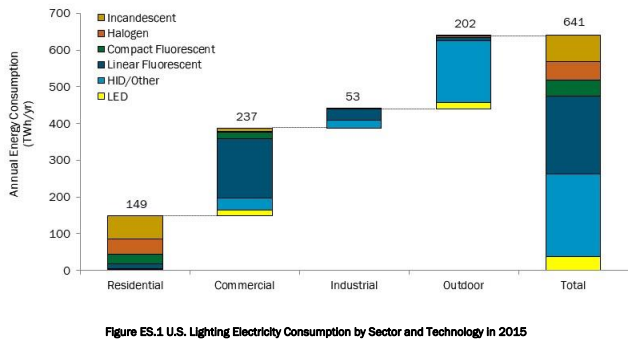The U.S. Department of Energy's (DOE) Solid-State Lighting Program has released a new report that estimates the installed stock, energy use, and lumen production of all general-illumination lighting products operating in the U.S. in 2015. The third such report issued by DOE since 2002, it provides the baseline that helps DOE plan its R&D program, and is used by both governmental and nongovernmental organizations for planning and evaluating lighting opportunities as well as additional research efforts.
Estimates in the new U.S. Lighting Market Characterization (LMC) were based on building-lighting audits, industry surveys, national lighting product shipment data, and interviews with lighting professionals and subject matter experts.
 |
|
(Source: The U.S. Department of Energy) |
Among the key findings:
-
U.S. lighting as a whole consumed 641 TWh of electricity, or approximately 17% of the country's total electricity use.
-
Approximately 37% of the lighting electricity was consumed in the commercial sector. The outdoor sector was the second-largest lighting electricity consumer, at 32% of overall consumption, while the residential sector ranked third at
23%.
-
Overall, LED lighting penetration into all sectors has made significant strides since 2010, representing 8% of overall lighting inventory in 2015 vs. less than 1% in 2010.
-
The outdoor sector ranks highest in LED penetration, at 23% of that sector's lighting inventory (up from 8% in 2010) -- followed by the commercial (10%, up from 2%), residential (7%, up from less than 1%), and industrial (4%, up from less than 1%) sectors.
-
Across all sectors, the lighting stock has become more efficient, with the average system efficacy of installed lighting increasing from 36 lm/W in 2001, to 39 lmW in 2010, and now to 51 lm/W in 2015. Overall, average lighting efficacy in the U.S. has increased by more than 40% since 2001.
For a closer look at the findings, read the full report.











